Wondering what animal left those footprints in your backyard? Wonder no more! We’ve compiled the complete guide for identifying tracks commonly found in North America. So, read on and discover which creature has been walking through your neighborhood recently.
Capturing Tracks
While each animal has specific attributes to its tracks, it’s important to remember that the appearance of tracks can vary. Factors like the type of substrate can morph or distort a footprint. Footprints in snow may be deeper and more distinct than those in sand or dirt. Thick mud captures tracks more clearly than watery silt. Temperature can play a big part in distorting footprints. As temperatures rise and snow melts, tracks become less distinct and may appear larger than they are.
If you want to see which animals are traveling through your backyard in a more controlled environment, you can set up a track station. A track station is an area used to capture footprints to record and identify animals that are in the area. Prepare an area with a substrate that will capture footprints, such as dirt, mud, wet sand, chalk, or plaster of Paris. You can bait the area with food or scents that appeal to the species you want to track.
Now, let’s take a look at what the tracks of different species look like.
Mountain Lion
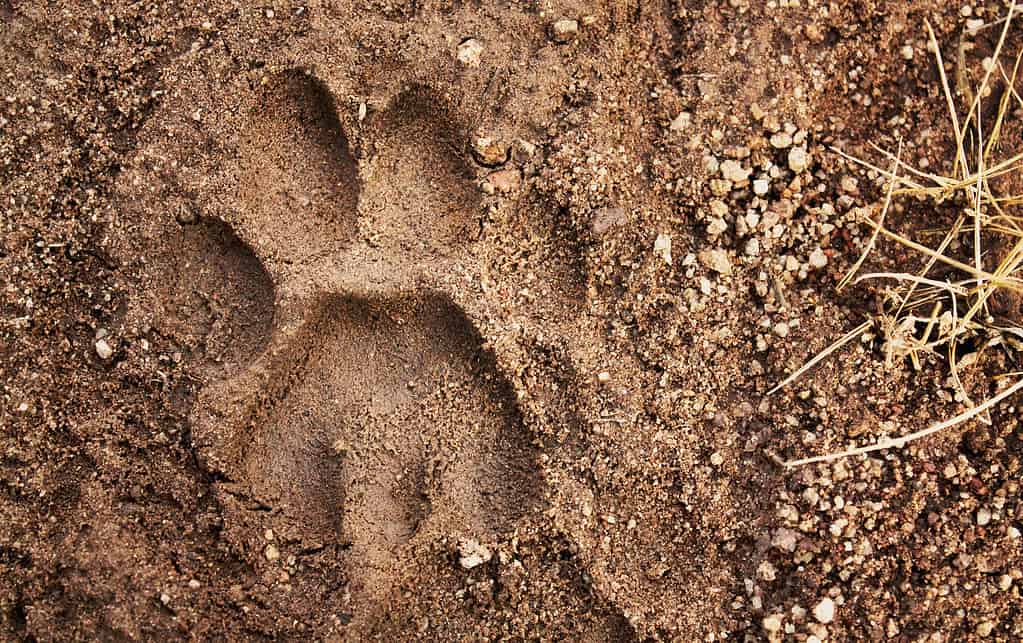
Cougar, panther, catamount, and puma are other names for the
mountain lion
.
©pvjones/Shutterstock.com
Mountain lions are found throughout Central and North America, from Chile all the way up into Canada. Their tracks are often mistaken for dog tracks, but a few differences can help you delineate between the two. Mountain lion paws are 3-5 inches wide with four asymmetrical toes and a large pad. The toes are teardrop shaped and claw marks are rarely (though sometimes) visible due to the retractable nature of the claws.
Find more information on mountain lion tracks here.
Rabbit

Rabbit tracks often form a Y pattern.
©Jack Dagley Photography/Shutterstock.com
While there are different species of rabbits throughout the United States, they generally move similarly. This means that rabbit tracks are usually laid out the same way. Typically, rabbit tracks will be a set of four tracks in a Y shape or rectangle, with the front feet in a staggered position. Rabbits’ back feet are larger than their front paws, so the back two footprints are longer. While rabbits do have toes, it is usually hard to distinguish between the individual toes in their tracks.
Find more information on rabbit tracks here.
Fox
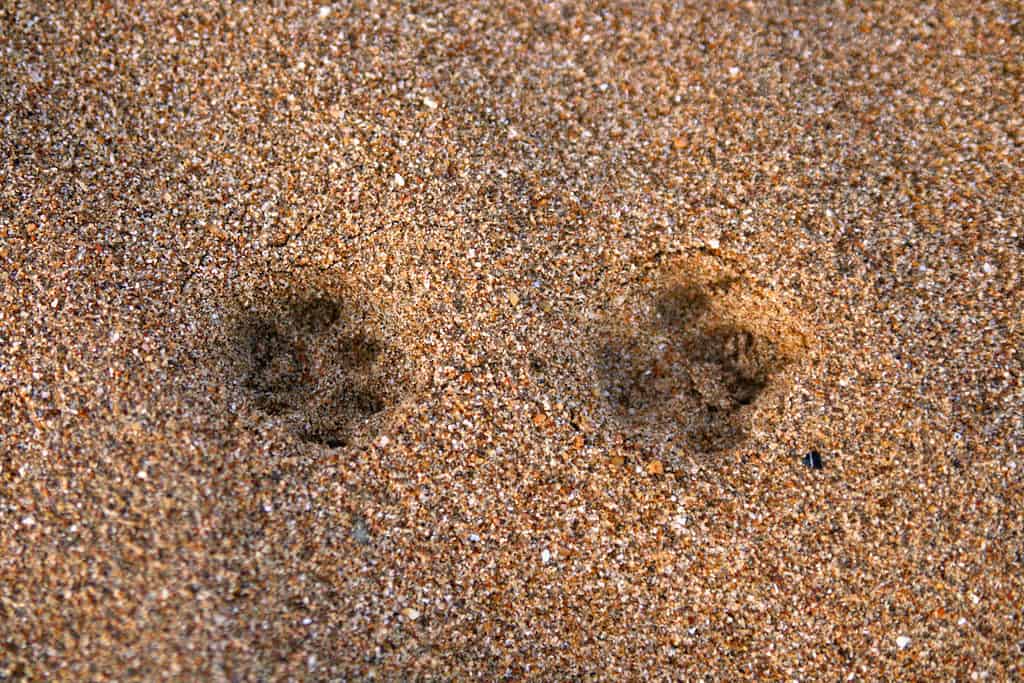
The red fox is the most common fox species.
©Keith Tarrier/Shutterstock.com
There are four fox species in North America and they vary in size. The American red fox is the largest and the kit fox is the smallest. Fox footprints generally measure 1.75-2.5 inches in length and 1.5-2 inches in width. Their prints are smaller in size than coyote or wolf tracks and are less deep than those of these heavier animals. Fox tracks have four toe pads and one palm pad with visible claw marks.
Find more information on fox tracks here.
Bobcat

Male bobcats can weigh up to 40 pounds.
©Bobcat tracks in the mud/Shutterstock.com
Bobcats are found throughout Central and North America, except in the Great Lakes region and parts of the Midwest. Smaller than mountain lions, bobcat tracks measure 1-3 inches across. They feature four asymmetrical toes and one palm pad. The footprints are round in shape and claw impressions are absent since their claws are retractable.
Find more information on bobcat tracks here.
Rat
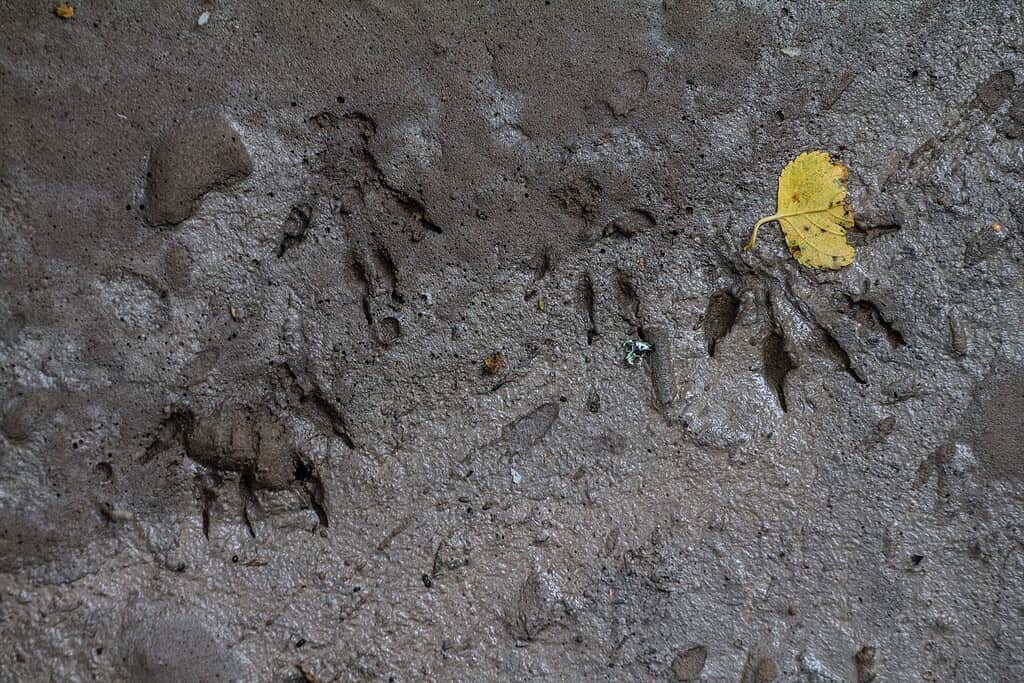
Rats can move each one of their whiskers individually.
©Maximillian cabinet/Shutterstock.com
These small mammals abound seemingly everywhere so finding their tracks should be no surprise. Rats have four paws with four toes on the front paws and five toes on the back. These toeprints usually look spread and defined. Their hind tracks are longer than the front prints. Rat footprints often have visible claws. Sometimes drag marks from their tails are visible as well.
Rat tracks alternate as they scurry along the ground leaving asymmetrical tracks. The left front and back paws are generally lined up, as are the right front and back paws.
Find more information on rat tracks here.
Wolf

Gray wolves are also known as timber wolves.
©Dennis W Donohue/Shutterstock.com
Wolves have five toes on their front feet and four on their back feet, although only four toes on the front feet touch while the animal is walking. Gray wolves leave large prints measuring around four inches wide and five inches long. Since their claws aren’t retractable, there are visible claw marks in their prints. Wolf tracks are often mistaken for dog or coyote tracks, but their prints are much larger than either species.
Find more information on wolf tracks here.
Bird

Gulls leave palmate tracks.
©iStock.com/Lubov
With many different species of birds, there are lots of variations in their tracks. However, bird tracks can be grouped into five main categories. These include:
- Palmate: Webbing between three tows and a hallux. Birds include ducks, geese, loons, and more.
- Game Birds: Hallux may appear reduced or missing. Birds include pheasant, turkey, coots, partridge, rails, grouse and more.
- Anisodactyl: One two points backward while three point forward. Birds include herons, egrets, songbirds, hawks, falcons, doves, vultures
- Totipalmate: Webbing between four toes. Birds include pelicans, gannets, cormorants, boobies, and more.
- Zygodactyl: Two toes pointing forward and two toes pointing back. Birds include owls, osprey, woodpeckers, parrots, and more.
Find more information on bird tracks here.
Otter

The otter’s claws are visible in its tracks.
©LukasPich/Shutterstock.com
River otters have partially webbed toes that are spread apart widely. Their prints measure up to four inches long and are about three inches wide. Otter feet have large C-shaped pads and five toes, which are often all visible in their tracks. Their sharp claws can sometimes make their toeprints look pointed.
Find more information on otter tracks here.
Snake
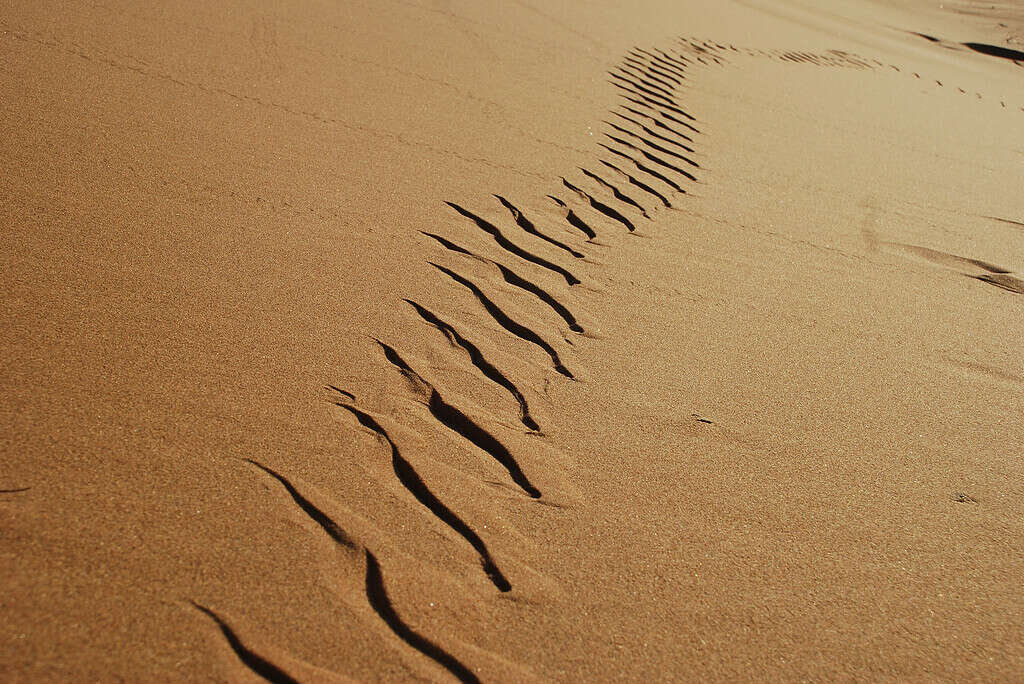
Sidewinder snake tracks are perpendicular to the direction of a snake’s movement.
©Piece of peace/Shutterstock.com
Snake tracks vary depending on how a snake moves. There are five different methods of movement in snakes, which include:
- Lateral undulation: Tracks form waves that arc from side to side
- Sidewinding: Creates tracks perpendicular to the snake’s movement direction, making a pattern that looks like a series of hash marks.
- Slide pushing: Irregular undulation on smoother surfaces that forms broad tracks.
- Concertina locomotion: The snake anchors its body to a surface and pushes or pulls its body towards or away from the anchored section.
- Rectilinear movement: Straight track caused by large, heavy snakes like boas and pythons.
Find more information on snake tracks and specific species tracks here.
Beaver
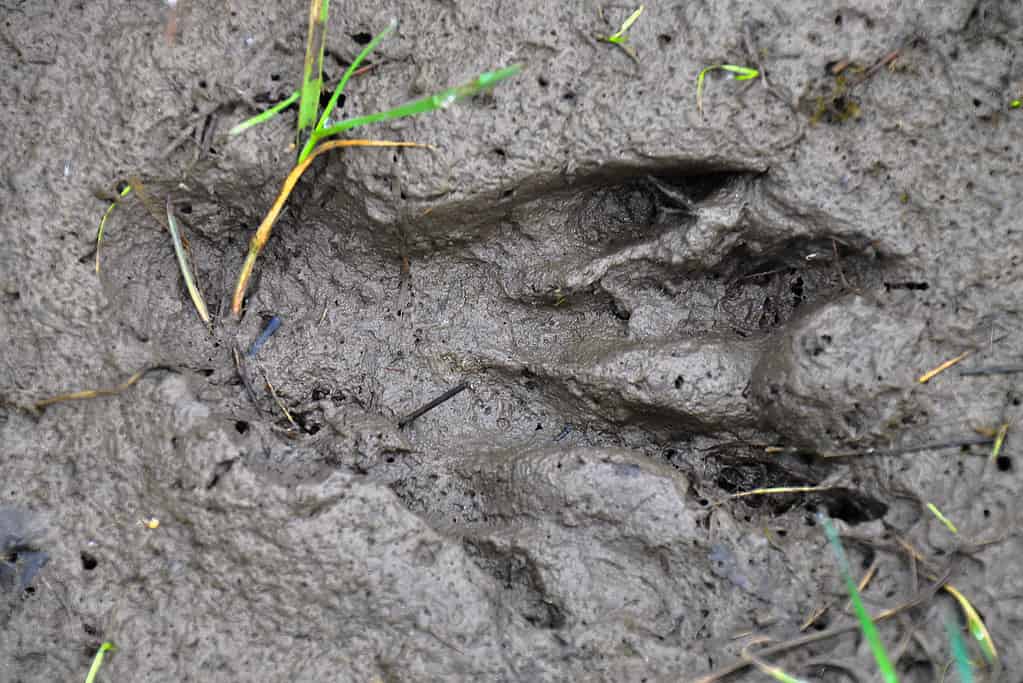
Tracks are often found near water sources.
©Marek Rybar/Shutterstock.com
Beavers have large tracks that measure 4-6 inches in width and length. Their prints have a kidney-bean-shaped pad with four distinct toe pads in a semicircle around the heel pad. This arrangement often resembles a human handprint. Beavers also often leave tail tracks as they drag their tails in snow.
Find more information on beaver tracks here.
Cat
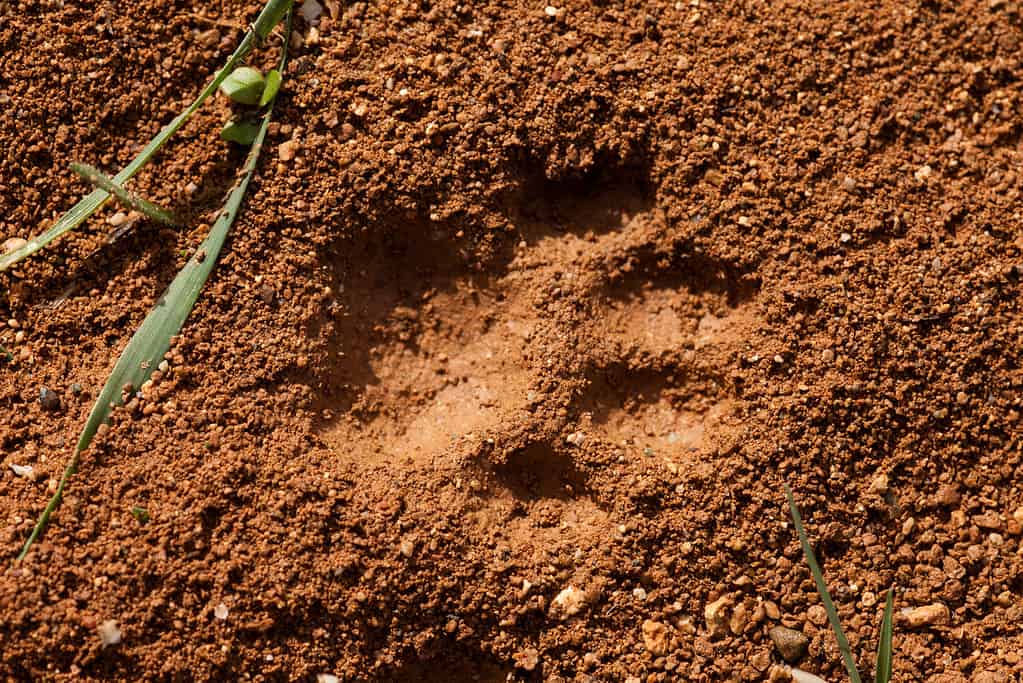
Retractable claws rarely show in tracks.
©Pi-Lens/Shutterstock.com
Cat tracks resemble tracks left by dogs, with a lobed central paw pad and four toe pads. However, cat prints do not have claw marks like dogs do since cats have retractable claws. Cat tracks are also smaller than the prints of most dogs, measuring around one inch in length and width. Their back pawprints are slightly larger than their front prints.
Find more information on cat tracks here.
Bear
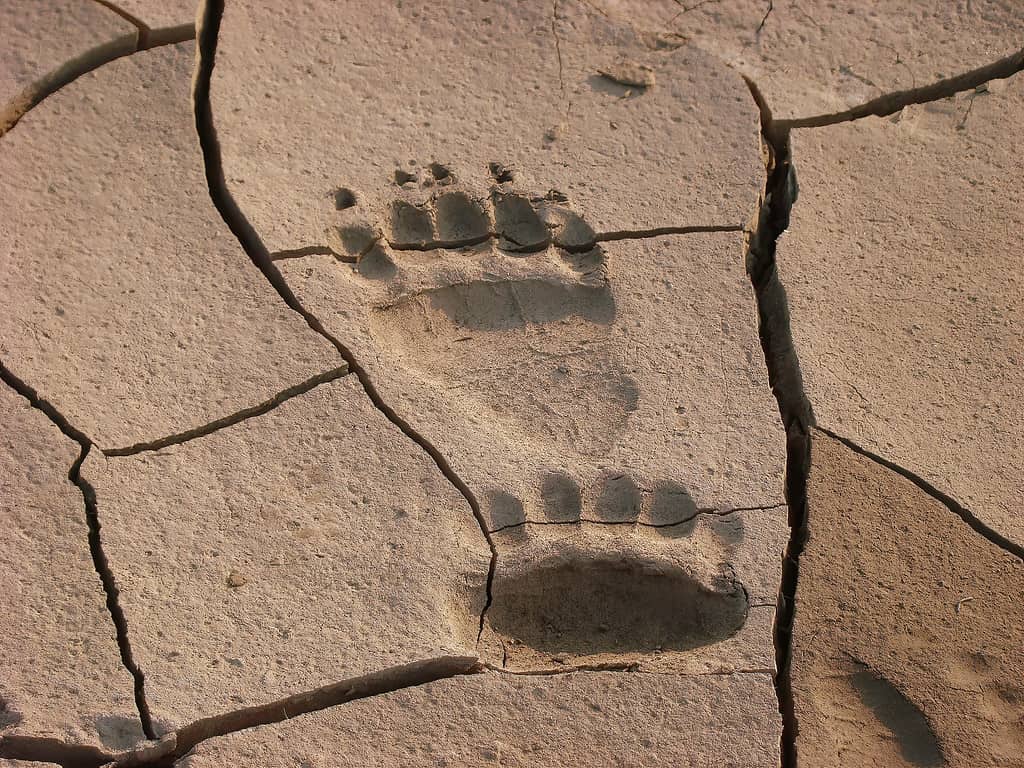
Grizzly bear
claws can be up to four inches long.
©John charles hansen/Shutterstock.com
Bears usually walk on the soles of their feet which can often make their prints hard to read. If a bear does leave a distinct print, it will feature five toes. Since bears usually walk on the outside of their feet, the inner toe will appear the smallest. The size of a bear track depends on the species, with rear tracks longer than the front tracks.
Find more information on bear tracks and specific species print sizes here.
Porcupine
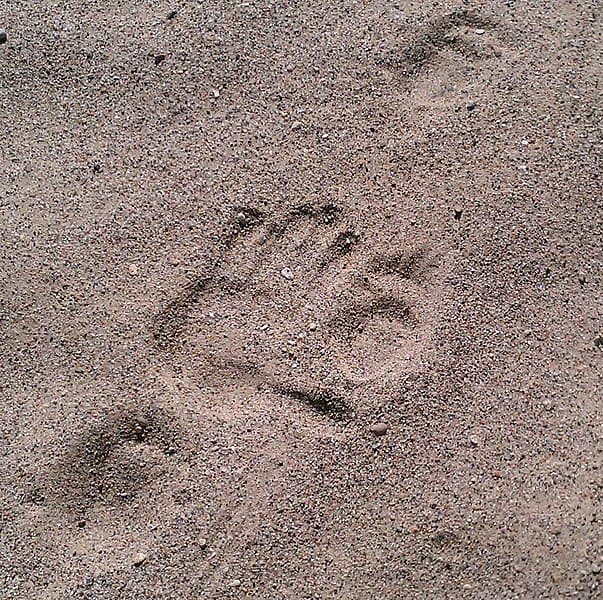
Porcupine
tracks often have tail drag marks.
©Lensim / CC BY-SA – License
It can sometimes be difficult to make out porcupine tracks thanks to their dragging tails which can obscure the prints. If prints are visible, the front paws measure 2.5 inches long, while the larger hind paws measure around 3.5 inches. Porcupines have five toes on their back paws and four toes on their front paws. Tracks usually have visible claw marks. Thanks to the texture of their heels that helps them grip and climb, their pawprints may have a pebbled appearance.
Find more information on porcupine tracks here.
Wolverine
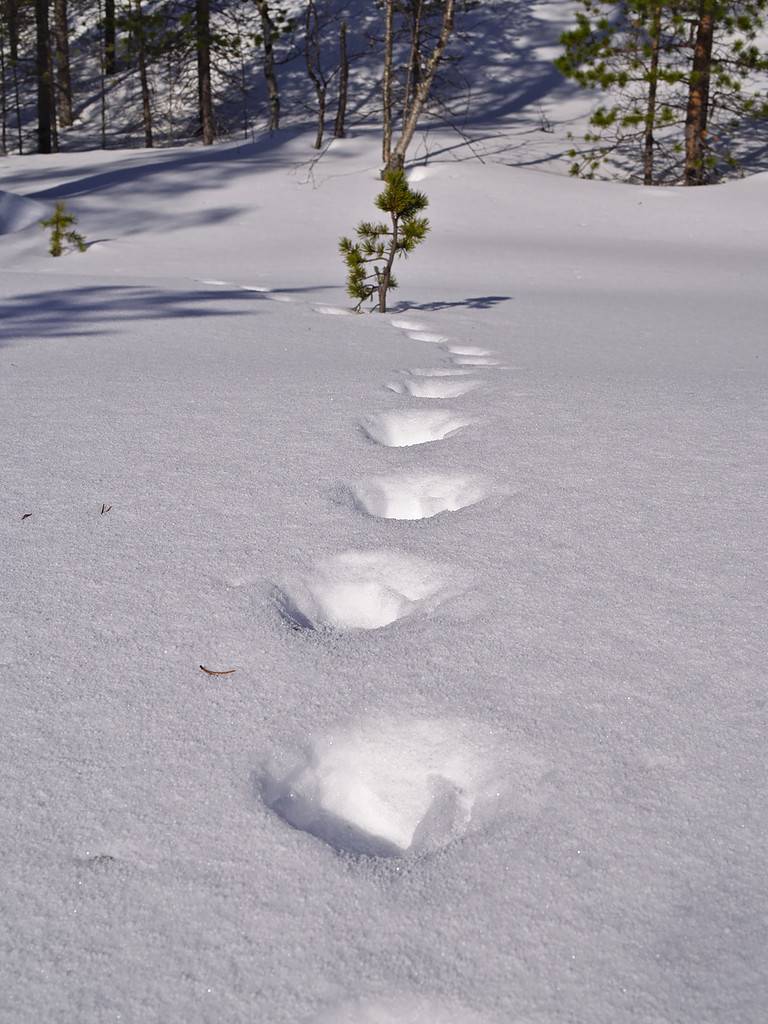
Snow often obscures the track shapes.
©Jarno Holappa/Shutterstock.com
Wolverine tracks are unique because they have multiple manners of locomotion, including jumping and galloping, which can change the track patterns. This results in some tracks being paired while others are in a diagonal line. Wolverines have five toes that form a triangular pawprint that is wider in the toes than the heel. Their tracks are around 3-4 inches in width with long claws measuring 3.9-4.7 inches.
Find more information on wolverine tracks here.
Fisher

Fishers have five toes but sometimes only four are visible in tracks.
©Abigail Crawford/Shutterstock.com
Native to the northern United States and Canada, the fisher is around the size of a cat. However, their footprints are different than that of cats, featuring five toes with visible claws. While the fifth toe is not always visible in prints, it is a good delineator between fishers and the many species that only have four toes. Fishers have a C-shaped metacarpal pad that makes the prints appear oval. Front feet measure 2-4 inches wide while hind feet are 1.5-3.5 inches wide.
Find more information on fisher tracks here.
Squirrel
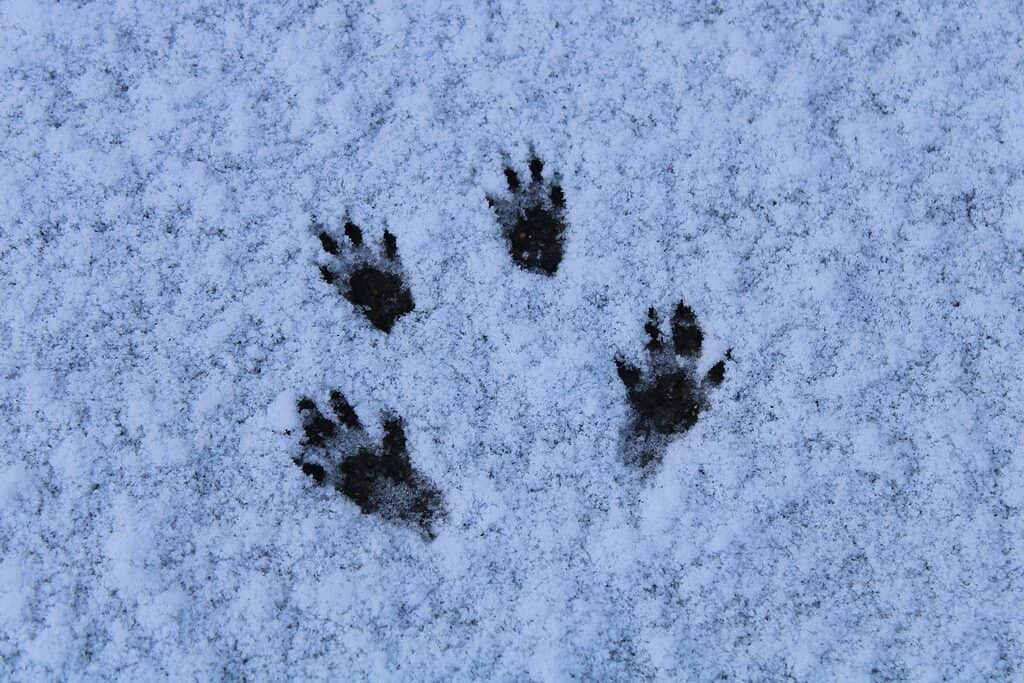
Eastern gray squirrels are a common
squirrel
in North America.
©Susan Edmondson/Shutterstock.com
Squirrel tracks can be easily identified by the difference in size between their front and back paws. A squirrel’s front paws look like little hands and measure about one half an inch long. In contrast, their back feet are an inch long. Their front feet have four toe pads and their hind feet have five toe pads. Small claw marks are also present in squirrel tracks. The paw grouping usually has the hind legs set wider than the front legs.
Find more information on squirrel tracks and specific squirrel species tracks here.
Moose

Moose tracks are larger than those of other hooved animals.
©Amelia Martin/Shutterstock.com
People in the northern United States and Canada may find moose tracks in their yard. In the lower 48 states, moose are most prevalent in Maine. Moose have four feet with hooves that measure 4.5-7 inches long and 3-5 inches wide. Their hooves are heart-shaped with a point in the front. They are considered even-toed ungulates, meaning that they have two hooved toes. Moose tracks resemble that of a deer but are much larger than other deer and other hooved species.
Find more information on moose tracks here.
Raccoon
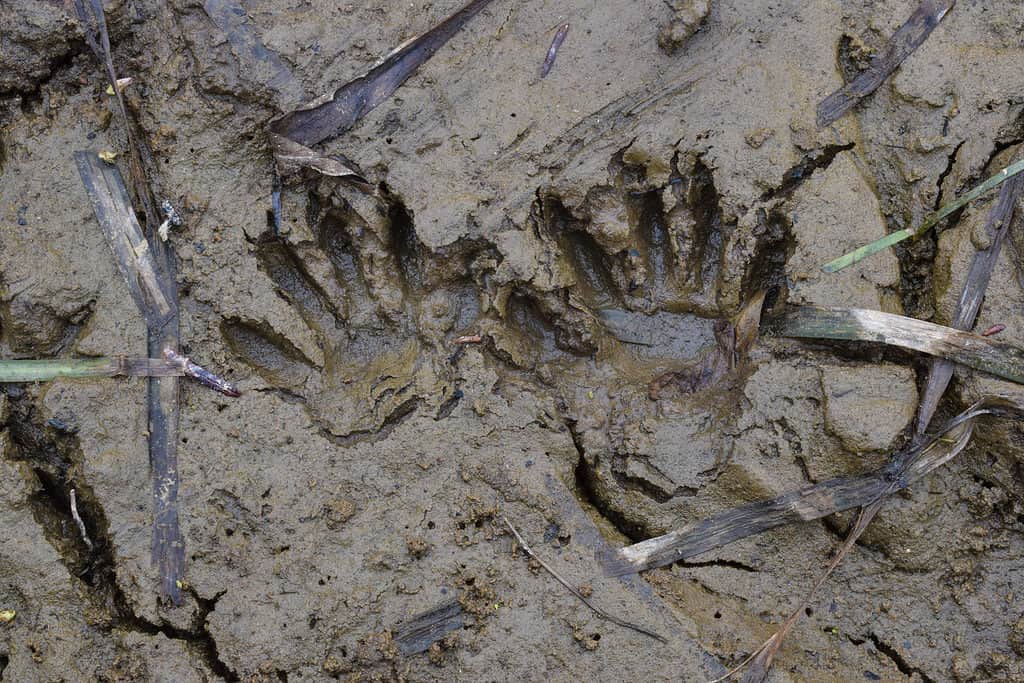
Raccoon prints resemble hands.
©K Steve Cope/Shutterstock.com
A raccoon’s front feet resemble little hands, with four fingers and a thumb. While a raccoon’s thumb is not opposable like a human’s, it still leaves a distinct print. The front prints of a raccoon typically measure 1-2.5 inches long, while the hind prints are 2-4 inches long. Raccoon prints feature a palm and five long fingers that are similar in length and all face forward. The claws are occasionally visible in raccoon tracks.
Find more information on raccoon tracks here.
Turkey

The middle toe is the longest in turkey tracks.
©K Steve Cope/Shutterstock.com
The wild turkey is a large bird that can measure up to 4 feet long and weigh an average of 22 pounds. Found throughout North America, the turkey has three long toes that make a triangular shape, with a smaller toe facing backward. The middle toe is the longest. Tracks are slightly wider than they are longer, measuring 3.5-4.5 inches long and 3.75-4.25 inches wide. Claws at the end of the toes give the toes a pointed shape.
Find more information on turkey tracks here.
Opossum
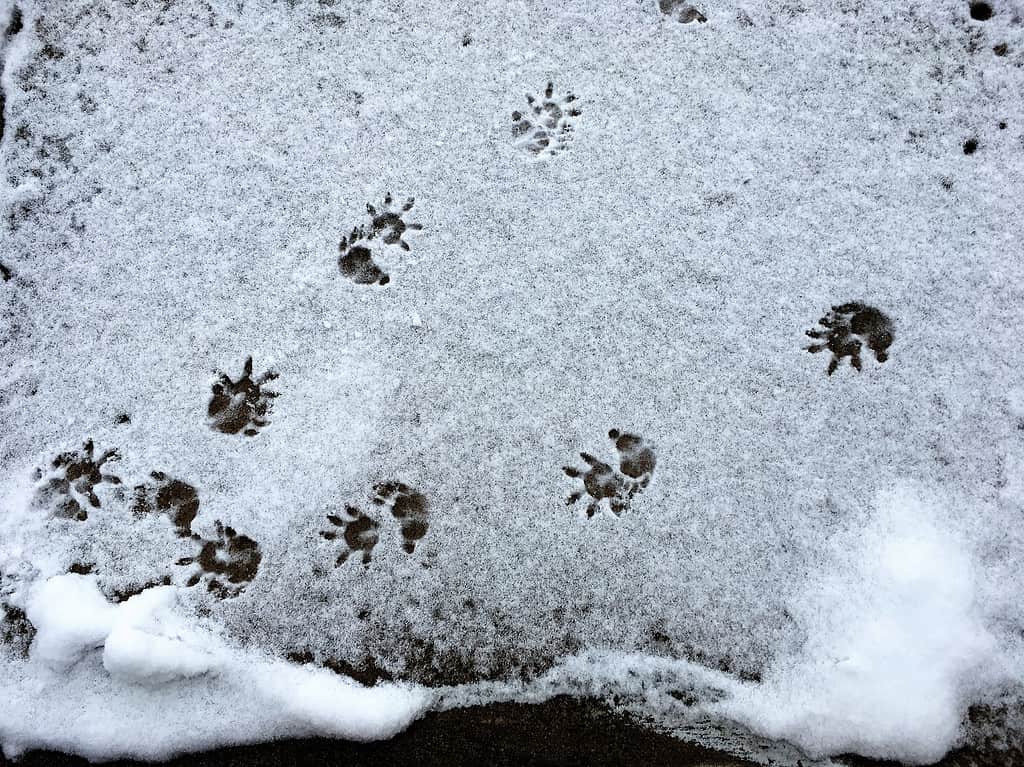
Opossum tracks have splayed toes.
©jelloyd/Shutterstock.com
North America’s only marsupial is a unique animal and their tracks are no different. Opossums are one of the only non-ape animals that have opposable thumbs. Both their front and hind feet have five distinct toes, much like a human hand. They have claws on four of their five toes, with no claw on their thumb. Tracks measure two inches wide and two inches long on their front feet, and around 2.5 inches on their hind feet. Unlike raccoon tracks, an opossum’s toes do not all point forward but have a splayed appearance.
Find more information on opossum tracks here.
Badger

Badger footprints have distinct claws.
©PARITNTUB/Shutterstock.com
With 15 different species of badger, their tracks can vary in size. Generally speaking, badger tracks are up to 2.5 inches wide with five toes and visible claw prints. Their pads have a broad kidney-shaped pad, and their front feet have longer claws that leave distinctive marks. On drier surfaces, these long claws will show more predominantly than the toes or paw pad. In contrast, their hind feet have shorter claws which don’t always show up in tracks.
Find more information on badger tracks here.
Weasel
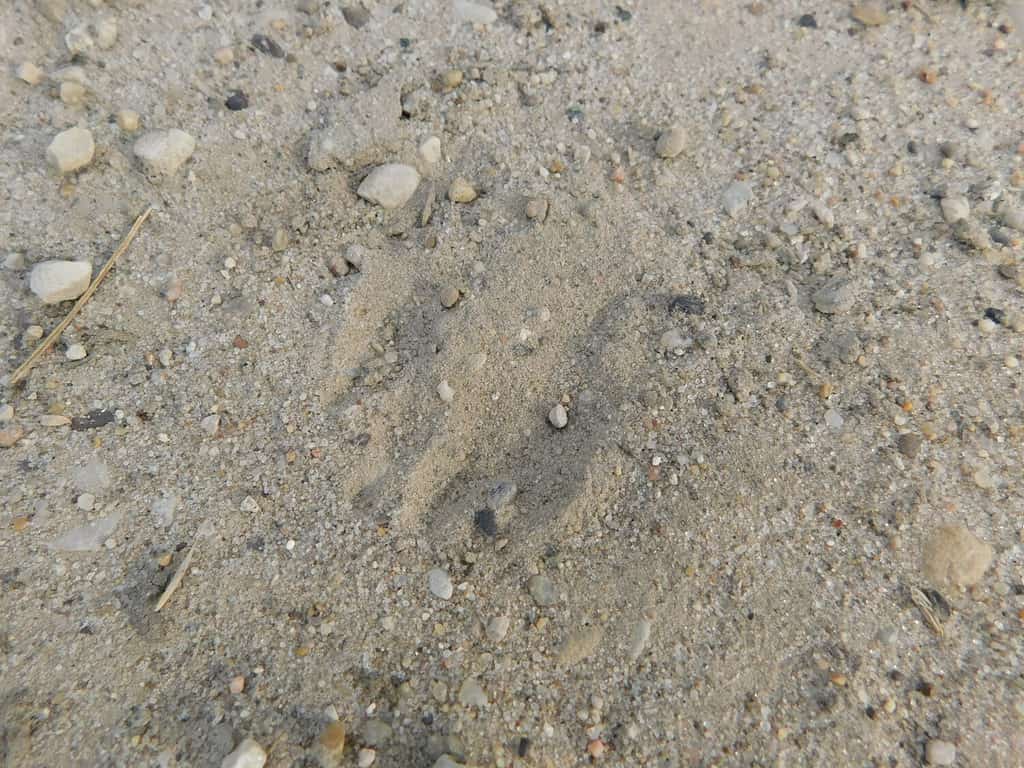
Loose substrates like sand aren’t the best for capturing animal tracks.
©Amanda Schell/Shutterstock.com
In North America, there are three different weasel species, with long-tailed weasels being the most common. Long-tailed weasels have elongated oval-shaped paws with a V-shaped pad. Weasel paws are considered pentadactyl, with five toes with non-retractable claws on each foot. While all of their feet have five toes, their front tracks show four digits while their hind paws show five. Tracks measure 0.5-1.5 inches long and 0.5-1 inches wide. Because of their gait, they typically leave a drag mark between their pawprints.
Find more information on weasel tracks here.
Armadillo
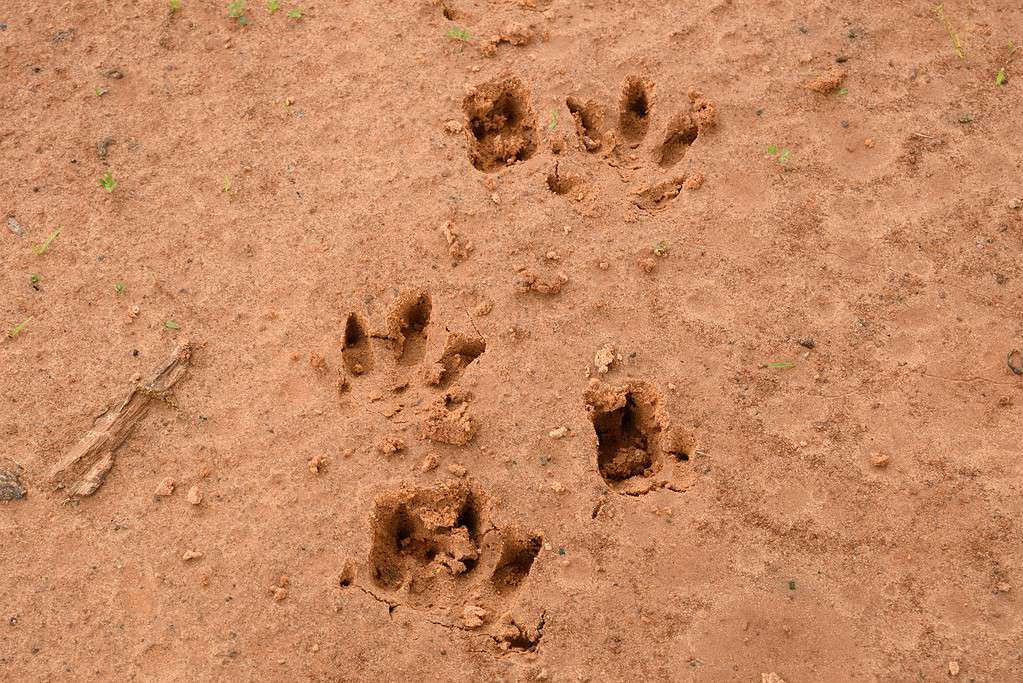
Each
armadillo
toe has a sharp claw.
©Sari Oneal/Shutterstock.com
The armadillo loves to dig for their dinner of grubs and insects and their long, sharp claws let them do so with ease. These claws show up clearly in armadillo tracks. Armadillo prints have four long toes, with the claw giving the appearance of a sharp tip at the end. Their toes are splayed, with a V-shaped gap between the middle toes. Armadillos drag their tails, so many sets of tracks feature a drag line down the middle of the pawprints. The size of the tracks varies by species.
Find more information on armadillo tracks here.
Elk
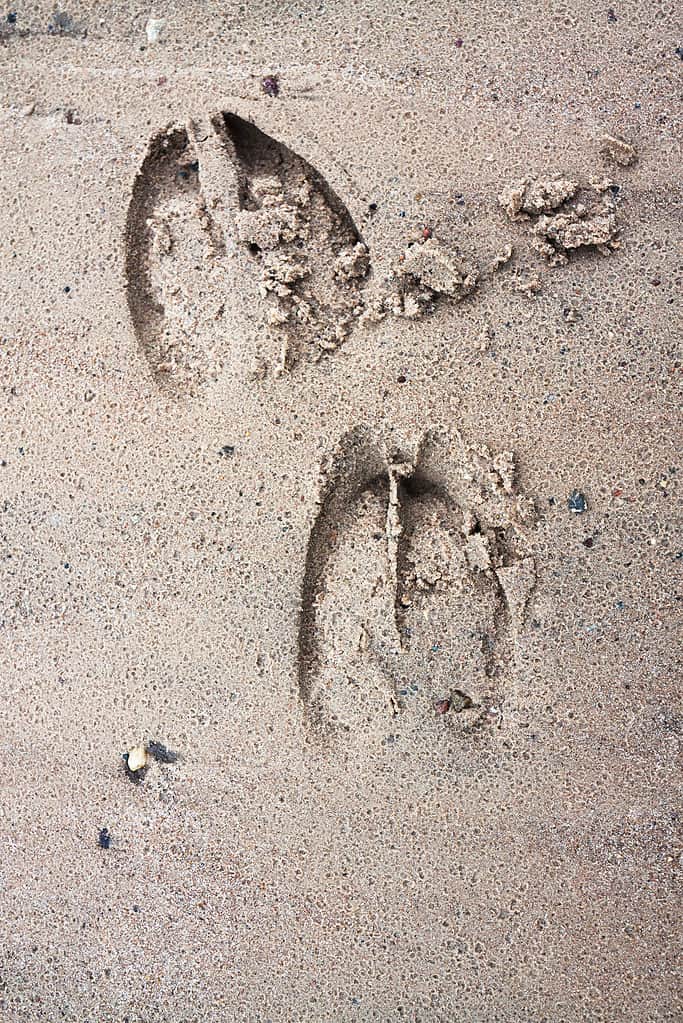
Elk tracks are smaller than moose tracks.
©iStock.com/yanikap
While not quite as large as moose tracks, elk footprints are much bigger than that of a deer. An elk’s front hooves measure 4-4.5 inches long and 3-4 inches wide with two hooved toes. The rear hooves measure 3.5 inches long and 3 inches wide. With a step length of 1.5-3 feet, elk tracks can be rather spread out. However, since they travel in herds it can often be difficult to make out which tracks pair up.
Find more information on elk tracks here.
Mouse
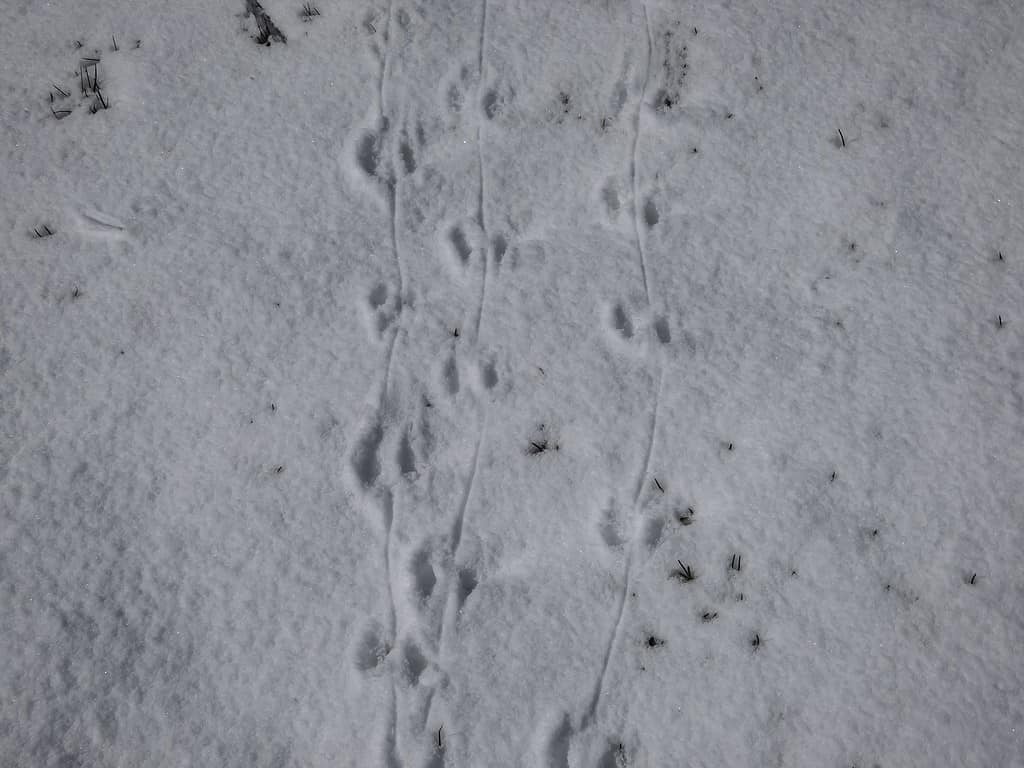
Mouse tracks sometimes feature tail drag marks.
©Kristine Rad/Shutterstock.com
The main difference between rat and mouse tracks is that mouse tracks are smaller than their larger counterparts. Mouse tracks range between 1/8 to ½ inches in length and width, depending on the species. Deer mice have the smallest tracks. Their front feet have four toes and their hind feet have five. While mice do have claws, they are not always visible in their tracks.
Find more information on mouse tracks here.
Skunk
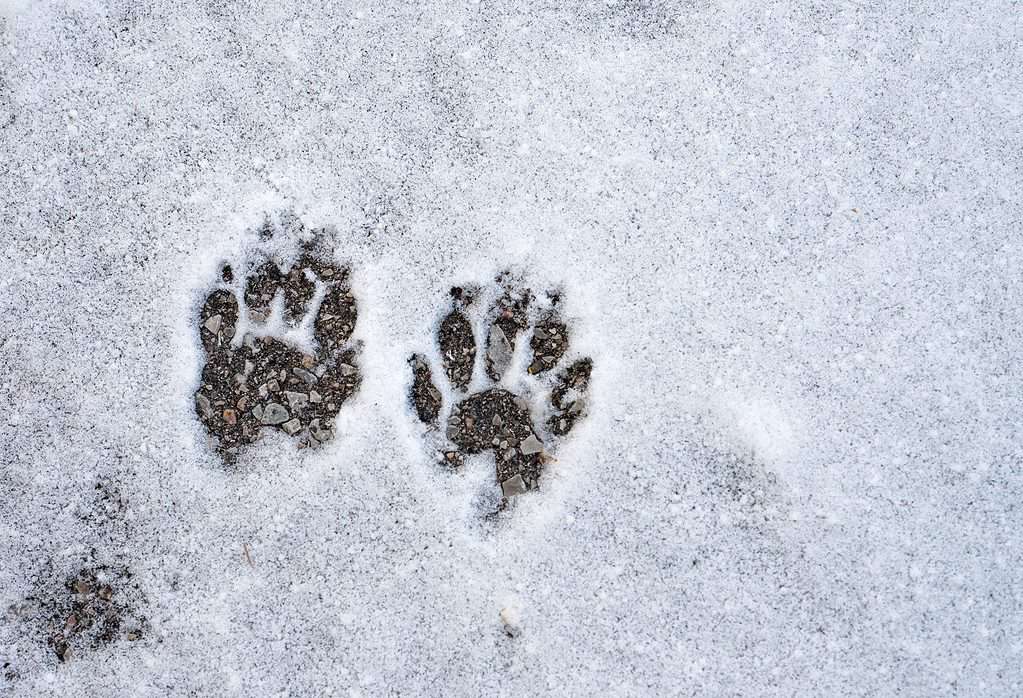
Skunks have five toes.
©LesPalenik/Shutterstock.com
Broadly distributed across North and Central America, the skunk has oval tracks that measure 1.5-2 inches. Their tracks have palm pads with five long finger marks on both the front and back feet. Claw marks are visible in skunk tracks, though the front claw marks are farther from the toepads than in the hind pawprints. Their toes are slightly splayed, differentiating their tracks from a raccoon’s. Look for claws on all five toes to differentiate the skunk’s tracks from an opossum’s prints.
Find more information on skunk tracks here.
The photo featured at the top of this post is © LesPalenik/Shutterstock.com
Thank you for reading! Have some feedback for us? Contact the AZ Animals editorial team.






